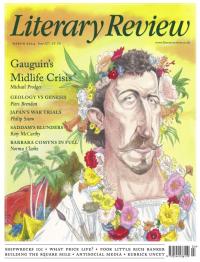Charles Elliott
Leeches, Stings & Lunacy
Pathless Forest: The Quest to Save the World’s Largest Flowers
By Chris Thorogood
Allen Lane 288pp £25
Chris Thorogood is a self-described ‘plant junkie’. The plant on which he is hooked is a bizarre one called Rafflesia, a parasitic monster found growing only in the Philippines and Indonesia and notable for its enormous, fleshy blossom. Pathless Forests is a sort of travelogue describing Thorogood’s journey around this part of the world in search of the beasts in bloom, something he had dreamed of undertaking since childhood (at the age of eight, in an abandoned cemetery behind his home in England, he went so far as to make a model Rafflesia out of papier-mâché and clay). Inevitably, he grew up to be a botanist and is now deputy director of the University of Oxford Botanic Garden.
It is easy to see the attraction of Rafflesia for botanists, perhaps less so for the average gardener. In full bloom, it can be over a metre across, with a large, round, cup-like centre surrounded by five lumpish petals. There’s nothing graceful about it: it huddles on the ground like an imaginary animal or oversized, partially flayed basketball. It can come in several colours but is generally red with white spots scattered over it. Some species stink profoundly – the smell of Rafflesia patma, for example, ‘hangs over the forest floor like a death’, according to Thorogood. Flies may cluster on it and inside its central orifice, serving as pollinators, while small animals like Sunda porcupines and Java mouse deer chew on the ripe flower. As a parasite that gets its nourishment by stealing from a particular variety of vine, rather like a tapeworm does from a human, it survives only thanks to a host of external factors. In sum, not much is known about Rafflesia, including where to find it. It is now extremely scarce, having suffered from the destruction of its environment and the effects of climate change. About forty species exist.
So being a Rafflesia tourist is obviously challenging. Thorogood’s first forays into promising areas of the Philippines, accompanied by a few local botanists and guides, were frustrating. His hope was to find good examples of several species, to learn how to propagate them and to analyse their relationships to one

Sign Up to our newsletter
Receive free articles, highlights from the archive, news, details of prizes, and much more.@Lit_Review
Follow Literary Review on Twitter
Twitter Feed
The era of dollar dominance might be coming to an end. But if not the dollar, which currency will be the backbone of the global economic system?
@HowardJDavies weighs up the alternatives.
Howard Davies - Greenbacks Down, First Editions Up
Howard Davies: Greenbacks Down, First Editions Up - Our Dollar, Your Problem: An Insider’s View of Seven Turbulent...
literaryreview.co.uk
Johannes Gutenberg cut corners at every turn when putting together his bible. How, then, did his creation achieve such renown?
@JosephHone_ investigates.
Joseph Hone - Start the Presses!
Joseph Hone: Start the Presses! - Johannes Gutenberg: A Biography in Books by Eric Marshall White
literaryreview.co.uk
Convinced of her own brilliance, Gertrude Stein wished to be ‘as popular as Gilbert and Sullivan’ and laboured tirelessly to ensure that her celebrity would outlive her.
@sophieolive examines the real Stein.
Sophie Oliver - The Once & Future Genius
Sophie Oliver: The Once & Future Genius - Gertrude Stein: An Afterlife by Francesca Wade
literaryreview.co.uk